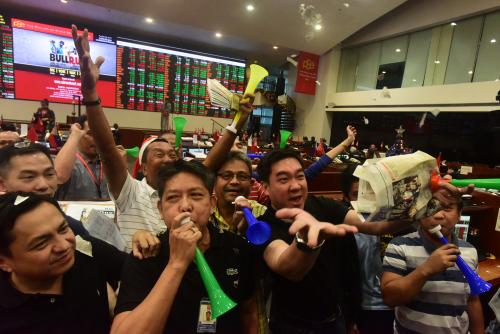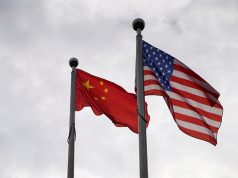Author Cesar Polvorosa Jr. is a business school professor of economics, world geography, and international business management in Canada. He is also a published writer in economics, business, and literature.
Background: A robust economy
The Philippine economy is currently one of the star performers of Asia. Since 2010, Philippine GDP has grown at a robust annual average rate of 6.3% (Table 1). Growth moderated to 5.0% for the 1st quarter 2015 but bounced back for an overall growth of 5.6% in the first three quarters of the year as government expenditures which dragged down growth in the first quarter recovered to a growth of 17.4%. Thus, the country continued to outperform most of the traditional economic achievers of Asia.
The economy has been dominated by services (57.4%) followed by industry (31.2%) and agriculture (11.3%) (2014). The country is well known as a dominant player in the BPO sector but it had also assumed a top 5 rank in the global shipbuilding industry. Meanwhile, the Philippine aerospace manufacturing industry projects that total market size expanded from $2.45 billion in 2013 to an expected $2.71 billion in 2015 (http://export.gov/philippines/eg_ph_030640.asp). The vehicle industry is booming with the Chamber of Automotive Manufacturers of the Philippines Inc. report that vehicle sales jumped 21% y-o-y as of September 2015 that mirrored the country’s growing incomes. Ship building, automotive, and aerospace industries are of strategic importance for the Philippine economy in the coming years.
The dynamics of economic growth
The Philippine economy is clearly ascending to a higher growth trajectory. The vigorous growth for 2010-2014 is the highest five-year average of the country in 40 years (Table 1). Philippine GDP per capita income reached $6,962(PPP) for 2014 (IMF est.) for a 26% increment over 2010 levels.
Table 1: Philippine Economy 1980 – 2014: Towards a Higher Growth Path
Ave. 5 Year GDP Growth in Percent (constant prices, 2000 base year)

Source: calculations by the author; raw data from Philippine Statistics Authority and IMF
The Philippines is well past the major political turbulence and governance crisis of the 1980s and 1990s that derailed economic expansion then. Optimism is high that the current vigorous growth of the country is sustainable for 2016 and beyond due to sound economic fundamentals and good governance reforms. A stable and gradually maturing democracy are instrumental in fostering conditions conducive to economic growth in the Philippines.
The country’s competitive advantage is its large, young, highly literate, English proficient labor force and market of 101 million (July 2015 est. CIA World Fact book).The country’s median age is 23.5 years and its population growth rate of 1.61% positions it to avail of the “demographic dividend” in future decades.
Philippine authorities implemented good governance and sound economic policies especially in the past decade in banking and finance, fiscal and competition policies. Subsequently, the fundamentals of the economy remain stable even as growth continues as supported by higher investments.
The Great Recession buffeted the Philippine economy but the country proved resilient. Its GDP growth decelerated to 1.15% in 2009 but recovered quickly to average 6.3% for the next five years. External debt-to-GDP ratio has considerably improved from 68.6% in 2003 to only 27.3% in 2014 (BSP). Similarly, Fiscal deficit has moderated to -0.6 in 2014 from an average of -2.3% in 2010-2013. Core inflation was a benign 3.0% in 2014 and decelerated further in 2015. Subsequently, the country received investment status upgrades from major international credit rating agencies Moody’s, Fitch, Standard & Poor’s, and Japan Credit Rating Agency.
Table 2 Philippine Economy 2010-2014: GDP Growth Rates and Levels

Source of data: BSP (Central Bank of the Philippines)
Philippine GDP’s biggest expenditure component is Household Final Consumption at about 69% and growing at an average of 5.3% during 2010-2014 (a faster 6.2% in the 2nd quarter 2015). Rebalancing the economy through a more vibrant industry sector is supported by the impressive 9.2% growth of manufacturing annually during the past two years (a slower 6.1% in the 2nd quarter 2015). With a broad based economic growth, the Philippines is increasingly attracting foreign investors – from a paltry $1.1 billion in 2010, Net Foreign Direct Investments (FDIs) jumped to a historical high of $6.2 billion in 2014.
Table 3 Philippine Economy 2010-2014: Trade, Foreign Investments, and Remittances

Sources of data: Philippine Dept. of Trade and Industry (Trade); BSP (NFDI and Remittances)
The country benefits from huge remittances which reached $24.3 billion in 2014 (3rd biggest in the world) from $18.76 million in 2010 (Table 3) and expected to hit $29.7 billion in 2015.
The China factor
Bilateral Philippines and China trade is surging reflecting a similar trend in trading with China of many countries. From 11.1 % of total exports in 2010, Philippine exports to China inched up to 13% in 2014. Meanwhile, Philippine imports from China rapidly grew at an annual average of 21.7% in 2010-2014. Thus, total Philippine trade with China now comprises 14% of total Philippine trade from 9.7% in 2010.
Table 4 Philippine Economy 2010-2014: Trade with China

Source: Philippine Department of Trade and Industry raw data
For both cyclical and structural reasons, China’s economic growth is expected to decelerate from 10% to 7% p.a. for the medium term. China is prioritizing its domestic market which translates to higher demand for imported consumer goods. Though the Chinese stock market bubble burst, the US economy remains strong which stabilized the global financial system. Likewise, while the slowdown of a major trading partner like China is expected to adversely affect the Philippines, the country is relatively insulated compared to major commodity exporters like Malaysia and Indonesia.
At the start of 2016, the fall in the Chinese stock markets rattled global financial markets. The Shanghai Composite lost 10%, while the Shenzhen Composite dropped 14.3% over concerns on the weakness and slowing down of the Chinese economy.
Subsequently, the US Dow Jones lost over 6% this week after concerns over the Chinese stock market fall and continuing rapid decline in oil prices.
It had been argued that a major reason in 2015 for the US Federal Reserve to hold off raising its key rates was the Chinese stock market meltdown from June. The US Fed raised only its interest rate in December when it appeared that the Chinese stock market has settled down combined with continuing strong US economic performance. Now, the volatility in the Chinese stock market has recurred right in the first week of 2016! In short, it’s likely that the economic moderating effect of higher rates had been unintentionally magnified by the fallout from the Chinese financial markets. How will the US Fed respond?
The US economy is still expected to remain the bastion of stability but it’s likely that if the turmoil in the Chinese stock market becomes a contagion as a reflection of the broader weakness of the Chinese economy then the US Fed may defer the further gradual increase of its interest rates in 2016. If the US economy loses its steam it’s even possible that the US Fed may revert to an accommodative policy so soon after its shift in monetary policy.
Speed bumps in 2015
Some 2015 indicators suggest the Philippines is hitting speed bumps after a five-year boom. Public underspending retarded growth but improved in the second quarter. Exports slipped by a huge 24.7% in September 2015. FDIs as well are expected to be at $6 billion in 2015 from $6.2 billion in 2014. These indicators bear watching as they have significant impact on business and the trajectory of the Philippine economy.
Major issues that impact on the medium term
The Philippines had been highly buoyant since 2010. The country is however at a critical juncture as there are significant developments that are external especially the volatile global economy and domestic such as the impending national elections which have repercussions on the economy.
Economic growth scenarios
The attainment of sustained political stability and progress towards good governance combined with prudent macroeconomic management has clearly lifted the country to a higher growth path.
It’s a measure of Philippine progress that ordinarily respectable GDP growth rates below 6% of around 5.5% for 2015 and below 6% for 2016-18 are now considered as the base case. In contrast, in 2000-2009, the average growth rate for the country was only 4.4 -4.5%.
The medium case scenario is an expansion of 5.5% to 6.0% for 2015 and 6.0% to 6.5% for 2016-18. The medium case is regarded as the highest likelihood of happening. The ADB has lowered its 2015 forecast from 6.4% to 6.0% while maintaining its 2016 forecast at 6.3%.
The best case scenario is an expansion for 2015 of 6.1%-6.5% GDP growth p.a. and 6.6%-7.5% GDP growth p.a. for 2016-2018.
These scenarios play out based on the convergence and degree of realization of both positive and negative factors. For the domestic issues the most important would be good governance, reforms, and political stability while for external Issues the most critical would be the state of the global economy. The government originally targeted a 7%-8% GDP increment in 2015 and 2016. However, government officials had just recently conceded that this growth rate range is now unlikely to be achieved.
Domestic issues
1. Good governance, reforms, and political stability
An election is usually a raucous affair in the Philippines which is now focused on the national election slated for May 2016. The elections matter not so much as there may be significant changes in policies as the polls are more of popularity contests. The political parties are defined more by their prominent personalities in leadership roles rather than their political and economic ideologies. What ultimately matters is how the conduct and results of the election are perceived and accepted. Without a clear mandate, very tight elections results are likely to be contested and lead to protracted legal disputes and demonstrations by the protagonists. Historically, heavy election spending stimulates strong economic performance and trigger inflationary pressures but the Philippine economy is at the stage that it can accommodate price pressures from the elections.
While Philippine politics are largely personality based, the best case scenario for MNCs and local businesses remains an administration party victory as it enhances continuity of bureaucratic processes, an intact core of technocrats and good governance reforms that had been cited for the impressive 6.3% average growth rate since 2010.
There was also an expectation that if the country had lifted restrictions on foreign ownership of Philippine businesses that FDIs will jump substantially – even way beyond the record setting $6.2 billion of 2014. This is an area of economic policy that bears watching in the next administration.
The major structural issues that the country has to resolve in the medium term and into the long term include the alarming poverty and inequality of income distribution in Philippine society, the persistence of high unemployment rate and crime, the environmental degradation and climate change.
2. Macroeconomic management
Stable macroeconomic fundamentals particularly in the form of low inflation and interest rates, strong BOP, and declining debt to GDP ratios arising from prudent monetary and fiscal policies considerably enhanced the sustainability of the robust growth rates during the past half decade. It has made the country resilient in the face of a volatile global economy and overcome any inflation and BOP pressures due to higher growth rates.
3. Infrastructure and public spending
The Philippines is notorious for having one of the poorest infrastructures in the region as evident in congested airports and seaports, dilapidated highways, monstrous traffic jams and slow internet. The massive infrastructure deficit if left unresolved hobbles business efficiency and places a ceiling on economic growth. The government expenditure program can be efficiently implemented by significant reforms of the new administration including the full implementation of the Public Private Partnership (PPP) scheme. Unfortunately, any short term fix is only palliative in nature and the infrastructure woes can only be significantly resolved through the implementation of major projects – which will however take several years.
4. Weather conditions
The degree of severity and frequency of typhoons during the rainy season traditionally influences the agricultural output and Philippine GDP growth. However, at this particular time the El Niño is also expected to contribute in dragging down economic growth through droughts in this region of the world and resulting shortages can trigger price pressures. Thus, much will depend on the strength of the El Niño for 2015-2016 in gauging its impact especially on Philippine agriculture.
International
1. The state of the global economy
The country had proven its resiliency in the volatile world economy for the past decade. This time a new round of uncertainty grips global markets led by the Chinese stock market meltdown and economic slowdown. Of major importance to the Philippines is the economic performance of its major trading partners US, Japan, South Korea, and China which will impact on the Philippines in varying degrees in terms of exports, imports, tourist arrivals, remittances of workers, and FDIs. Global stock markets are expected to remain bearish in the short term. The hike in US interest rates is not expected to be of significant concern especially as it had been accommodated into expectations. What is vital is that the US is able to manage sustainable growth to provide a much needed lift for Philippine exports, remittances, and FDIs.
2. Black swan events
Of increasing use in international business and geopolitics is the term “black swan” theory or events as developed by scholar and risk analyst Nassim Taleb. “Black Swans” are major unforeseen or surprise events that have major impacts such as the terrorist attacks in Paris and the global market meltdown. Thus, there are the possible black swan events in 2016 especially in the context of international terrorism, economic volatility and geopolitical hotspots ranging from the Middle East, Ukraine to the West Philippine Sea that will possibly impact on business and economic performance. I have previously mentioned the prevalence of black swan events as characteristic of the Age of Uncertainty of the world economy. http://www.interaksyon.com/business/96274/focus–philippines-in-a-new-era-of-global-uncertainty.
3. Trans Pacific Partnership, ASEAN Economic Community, and Asian Infrastructure & Investment Bank (AIIB)
Foreign investors entering the Philippines can easily link up with the economies of other ASEAN (Association of South East Nations) countries through the ASEAN Economic Community. However, in the case of the Trans Pacific Partnership (TPP) the Philippines is not included in the founding group of a dozen countries that were party to the TPP trade agreement. The country though is seriously studying the opportunity to be in the next group of countries that will be a member of the TPP that makes up 40% of the world economy and promises to promote free trade through the lowering of barriers to trade and the facilitating and the protection of foreign investments. The Philippine membership in the newly established AIIB is not expected to yield immediate benefits in 2016 but is a positive development for the financing of vital infrastructure projects starting in the medium term.
4. Oil prices
The recent decline of oil prices had a largely beneficial impact on a major oil consuming country like the Philippines. Due to the confluence of both supply and demand factors such as a slowing Chinese economy and surplus oil production the growth of US shale oil, the soft oil prices are expected to continue into the medium term. Such lower oil prices are expected however to impact negatively on Mid-East producers which will affect remittances of Filipino overseas workers based in the Middle East underscoring the complex web of relations in the era of globalization.
5. Relations with China
The West Philippine Sea is identified as one of the potential flashpoints in the world due to the escalating territorial dispute between China and other claimant countries in the region particularly Philippines and Vietnam. The general expectation is that the political tension though simmering will continue to be managed and not erupt into a shooting war. The slowdown of the Chinese economy is a source of greater concern due to its impact on the Philippine economy though the country remains less affected than China’s major trading partners in the region. However, should there be a major deterioration in the relations between China and the Philippines, the major adverse impacts can be trade embargoes, slowdown in tourism arrivals, and investments between the two countries.
Moving forward
The Philippines is highly competitive in several areas, has a vibrant consumption driven economy, strong remittance flows from its huge Diaspora, healthy macroeconomic fundamentals, stable governance, and relatively limited exposure to foreign markets compared to its neighbors. While it is imperative that the country resolve its major structural issues and challenges, at least for 2016 and the next few years, its advantages has relatively shielded the Philippine economy from the worst of the global volatility and highlighted its status as a rising economic star of Asia.










